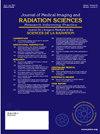FOCUS DWI and Deep Learning Reconstruction in breast MRI: A comparison with conventional DWI
IF 1.3
Q3 RADIOLOGY, NUCLEAR MEDICINE & MEDICAL IMAGING
Journal of Medical Imaging and Radiation Sciences
Pub Date : 2024-10-01
DOI:10.1016/j.jmir.2024.101543
引用次数: 0
Abstract
Purpose
To employ deep-learning based reconstruction (DLR) to improve the SNR of FOCUS DWI for breast imaging in Asian patients and investigate the feasibility and performance of reduced-FOV FOCUS DWI and FOCUS DWI with deep learning-based reconstruction (DLR) for breast MRI in Asian patients with small breast volumes.
Materials and Methods
Forty-nine female patients suspected of having breast cancer from July 2023 to December 2023. They underwent breast MRI examinations using three sequences: Conventional DWI, Focus DWI, Focus-DLR DWI. Two radiologists independently assessed image quality using a 5-point Likert scale. They also outlined the lesions, calculating the signal-to-noise ratio (SNR) of the lesion, the Contrast-to-Noise Ratio (CNR) between the lesion and surrounding tissue, and the Apparent Diffusion Coefficient (ADC) of the lesion. Image scores, SNR, CNR and ADC were compared using the Friedman test.
Results
FOCUS-DLR DWI had higher scores in terms of the overall image quality, the anatomical details, lesion conspicuity, artifacts and distortion than conventional DWI (P<0.001, P<0.001, P<0.001, P<0.001, P<0.001). The SNR of FOCUS-DLR DWI was higher than that of conventional DWI and FOCUS DWI (P<0.001, P<0.001), while there were no statistically significant differences between FOCUS-DWI and conventional DWI(P>0.05). What's more, in terms of CNR values and ADC values, there were no significant difference among three sequences.
Conclusion
Our findings indicate that FOCUS DWI with deep learning-based reconstruction produces superior images than conventional DWI, enhancing the applicability of this technique in clinical practice. Deep learning-based reconstruction provides a new direction for optimizing DWI imaging techniques in Asian breast MRI.
乳腺 MRI 中的 FOCUS DWI 和深度学习重建:与传统 DWI 的比较
目的采用基于深度学习的重建(DLR)提高亚洲患者乳腺成像中 FOCUS DWI 的信噪比,并研究缩小 FOV 的 FOCUS DWI 和基于深度学习的重建(DLR)的 FOCUS DWI 在乳腺体积较小的亚洲患者中用于乳腺 MRI 的可行性和性能。她们接受了三种序列的乳腺 MRI 检查:传统 DWI、聚焦 DWI 和聚焦-DLR DWI。两名放射科医生使用 5 点李克特量表独立评估图像质量。他们还对病灶进行了勾画,计算了病灶的信噪比(SNR)、病灶与周围组织的对比噪比(CNR)以及病灶的表观扩散系数(ADC)。结果FOCUS-DLR DWI 在整体图像质量、解剖细节、病变清晰度、伪影和失真方面的得分均高于传统 DWI(P<0.001, P<0.001, P<0.001, P<0.001, P<0.001,P<0.001)。FOCUS-DLR DWI的信噪比高于传统DWI和FOCUS DWI(P<0.001, P<0.001),而FOCUS-DWI与传统DWI之间的差异无统计学意义(P>0.05)。结论我们的研究结果表明,基于深度学习重建的 FOCUS DWI 可生成优于传统 DWI 的图像,提高了该技术在临床实践中的适用性。基于深度学习的重建为优化亚洲乳腺磁共振成像中的 DWI 成像技术提供了新的方向。
本文章由计算机程序翻译,如有差异,请以英文原文为准。
求助全文
约1分钟内获得全文
求助全文
来源期刊

Journal of Medical Imaging and Radiation Sciences
RADIOLOGY, NUCLEAR MEDICINE & MEDICAL IMAGING-
CiteScore
2.30
自引率
11.10%
发文量
231
审稿时长
53 days
期刊介绍:
Journal of Medical Imaging and Radiation Sciences is the official peer-reviewed journal of the Canadian Association of Medical Radiation Technologists. This journal is published four times a year and is circulated to approximately 11,000 medical radiation technologists, libraries and radiology departments throughout Canada, the United States and overseas. The Journal publishes articles on recent research, new technology and techniques, professional practices, technologists viewpoints as well as relevant book reviews.
 求助内容:
求助内容: 应助结果提醒方式:
应助结果提醒方式:


